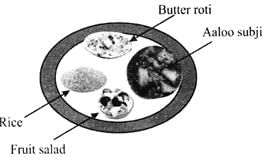Test: Human Body and Their Needs- 2 - Class 5 MCQ
10 Questions MCQ Test - Test: Human Body and Their Needs- 2
Most of the movements of the body are mediated by muscles and joint actions. Which of the following movement does not involve muscle and joint action?
| 1 Crore+ students have signed up on EduRev. Have you? Download the App |
The rib cage has twelve pairs of ribs, the last two pairs are called
Which of the following is / are component(s) of balanced diet
Rajesh's friend invited him for a lunch and served a thali containing rice, butter roti, fruits salad and aaloo subji. Which important component of the balanced diet is missing in this thali?

Process of developing immunity to fight against diseases after inoculation the germs is called
Which of the following articles can provide fastest energy to the body?
Backbone is not a single bone. It is a number of bones to provide movement called vertebrae. What is number of vertebrae in us?
Which of the following is protection covering over the heart and lungs?
Which of the following vitamin can be produced in our body in the presence of sunlight?

















